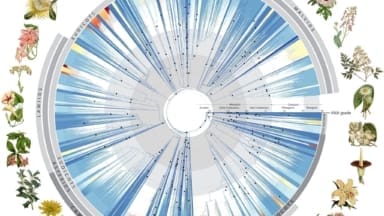
Using 1.8 billion letters of genetic code from over 9,500 species covering almost 8,000 known flowering plant genera (ca. 60%), a cunning global team of scientists have been able to build the ‘Angiosperm Tree of Life‘. This groundbreaking ‘period table’ of plants, sheds new light on the evolutionary history of flowering plants and their rise to ecological dominance on Earth. The tree can inform plant classification, discovery of new medicines and aid the conservation of plants.
Led by the Royal Botanic Gardens, Kew, the team behind the genomic tree involved 279 scientists representing 138 organisations from around the world, and is the most comprehensive of its kind ever made. This major milestone for plant science was built on 15 times more data than any comparable studies of the flowering plant tree of life. The sheer amount of data unlocked by this research, which would take a single computer 18 years to process, is a huge stride towards building a tree of life for all 330,000 known species of flowering plants – a massive undertaking by Kew’s Tree of Life Initiative.
The study’s authors believe the data will aid future attempts to identify new species, refine plant classification, uncover new medicinal compounds, and conserve plants in the face of climate change and biodiversity loss.
Dr Alexandre Zuntini, Research Fellow at RBG Kew, said; “Analysing this unprecedented amount of data to decode the information hidden in millions of DNA sequences was a huge challenge. But it also offered the unique opportunity to reevaluate and extend our knowledge of the plant tree of life, opening a new window to explore the complexity of plant evolution.”
Dr Sandra Knapp, Research Botanist at the Natural History Museum, who helped assemble the community to contribute material for the nightshade family in the study, commented, “This study represents a massive collective effort on the part of plant diversity scientists – working together we can really achieve so much more and create a solid basis for future collaborative understanding.”
Our understanding of how flowering plants came to dominate the scene soon after their origin 140 million years ago has baffled scientists, including Charles Darwin, for generations. Darwin was mystified by the seemingly sudden appearance of such diversity in the fossil record, calling it an ‘abominable mystery’.
Utilising 200 fossils, the authors scaled their tree of life to time revealing how flowering plants evolved across geological time. They found that early flowering plants did indeed explode in diversity, giving rise to over 80% of the major lineages that exist today shortly after their origin. However, this trend then declined to a steadier rate for the next 100 million years until another surge in diversification about 40 million years ago, coinciding with a global decline in temperatures. These new insights can help today’s scientists understand how and why species diversify.
For this study, new genomic techniques were developed to magnetically capture hundreds of genes and hundreds of thousands of letters of genetic code from every sample. This enabled a wide diversity of plant material, old and new, to be sequenced, even when the DNA was badly damaged. The team even analysed extinct plants, such has the Guadalupe Island olive (Hesperelaea palmeri), which has not been seen alive since 1875, but was sequenced from dried plant material preserved in the herbarium. In fact, 511 of the species sequenced are already at risk of extinction, according to the IUCN Red List.
The vast treasure troves of dried plant material in the world’s herbarium collections, which comprise nearly 400 million scientific specimens of plants, some obtained as far back as the nineteenth century, can now be studied genetically using these techniques. As well as material sourced from herbaria across 48 countries, the team also benefited from publicly available data for over 1,900 species, highlighting the value of open science to future genomic research.
Open access to this new tree and the data which underpins it, including through the Kew Tree of Life Explorer, could have enormous potential in future biodiversity research. Scientists can use the tree to understand and predict how pests and diseases are going to affect UK plants in the future, for example, or assess which plant species may include molecules with medicinal potential.

